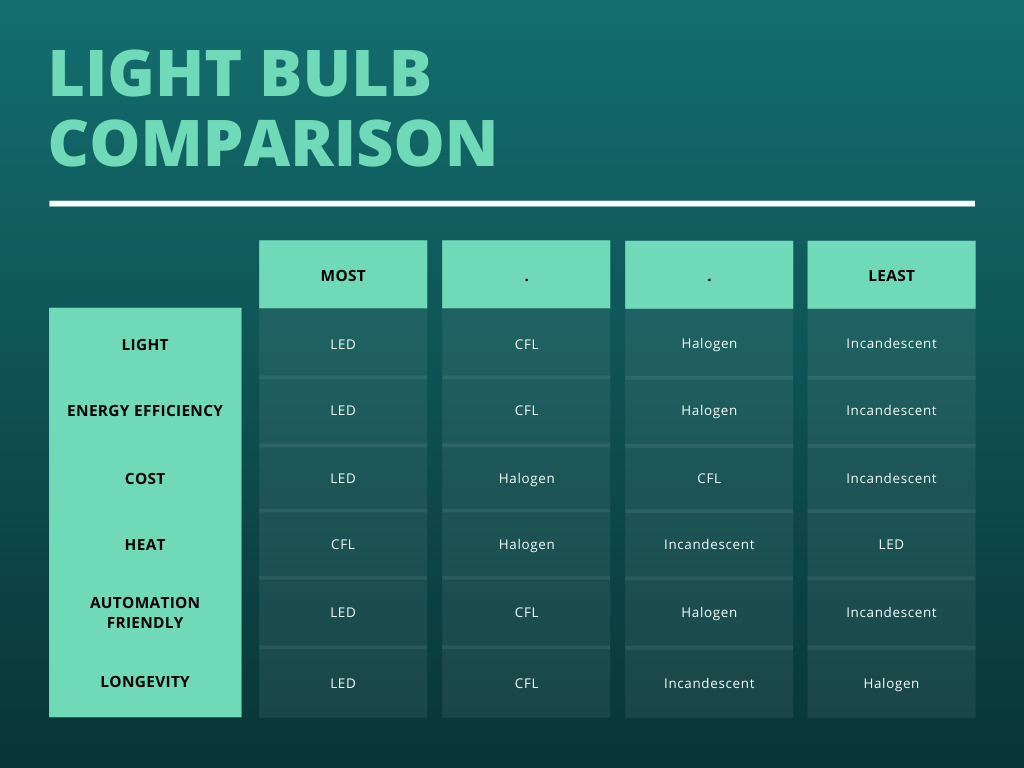
A Beginner’s Guide to Light Bulbs
Everything You Need to Know to Choose the Right Light Bulb for Your Home

Imagine this: you look up, and notice that your ceiling light has a burnt-out bulb. You check the closet and realize you’re out of replacements. So you go to the store and realize there’s an entire aisle full of light bulbs in different boxes with different names and shapes and ratings. This was supposed to be a simple trip, but now you have to start googling. Sound familiar?
It looks like a lot of technical jargon, and it kind of is, but don’t worry. We’ve put together the things you actually need to know, so that you can skip past the shopping nightmare and get right to the bulb you need.
Light Bulb Types

Incandescent
Incandescent bulbs are the original light bulb. They give off light by sending electricity through a thin filament, which glows when it heats up. They emit a warm yellow light and are dimmable. These bulbs are easy to find and are typically the least expensive option. Incandescent bulbs last for around a year, which is longer than halogen bulbs, but shorter than CFL and LED bulbs.
Incandescent bulbs are the least energy-efficient bulb on our list, which has landed them on the blacklist of environmentalist legislation in several countries over the last 15 years, including China and the United States.
Halogen
This bulb has the shortest lifespan of the four. They emit a light very similar to incandescent bulbs, and they cost a little bit more because they are much more efficient. They do have a drawback- they heat up very quickly, so they need to be kept away from combustible materials. Use gloves when you handle these bulbs, as the oil from your hands can make them explode when they get hot.
CFL
Short for Compact Fluorescent Lamp, CFLs are energy-saving bulbs that come in a wide range of colors. They last longer than incandescent bulbs and are less expensive than LED lights, so they can be a good choice for large rooms. It’s important to note that they usually take time to warm up and get to full brightness, and they produce a lot of heat. They contain mercury, so handle and dispose of them with care.
LED
LED bulbs are the latest technology in the light bulb industry. Despite being the most expensive option of the four, they’re wildly popular for a number of reasons. They can last up to 50,000 hours, which means they hardly ever need to be replaced. To put that in perspective, if you left an LED bulb on for 12 hours a day, every day of the week, it would last for 11 years! They also produce so little heat they are cool to the touch even after hours of running. This makes them a very safe option when it comes to lighting your home.
LED bulbs are the holy grail of customizable lighting. They are dimmable, come in a wide variety of colors (some can even change hues), and come in outdoor-rated varieties. Many use smart technology, so they can be linked to your Google Home or Alexa. LED bulbs are a great option anywhere in your home, but we especially recommend them for hard-to-reach fixtures that you don’t want to change very often.
Light Bulb Glossary Terms

Base: The portion of the light bulb that connects the bulb itself to the light fixture is called the base. Light bulb bases come in several sizes, so be sure to check your old bulb. Most household light bulbs have a base with a letter-number combination such as E12. The letter represents the base shape (in this case, Edison), and the number represents the width of the base, usually in millimeters.
Watts: This is a measurement of power, representing the energy transfer of the bulb. A 60 watt lightbulb “consumes” 60 joules of energy per second. Energy efficient light bulbs can produce the same amount of light using fewer watts, so they cost less money to run.
Lumens: This is a measurement of light, representing how much light is being emitted per second. Light bulbs with high lumen ratings give off more light.
CRI: This acronym stands for “Color Rendering Index.” Colors appear differently under different lighting conditions, so the CRI score tells you how well a light bulb will show you the true colors of objects. Bulbs are rated from 0-100, with 0 meaning all colors will appear the same and 100 meaning that all colors will be true. A bulb with a CRI above 80 is good, and 90 is great. Incandescent and halogen bulbs have a CRI of 100. This rating has nothing to do with light temperature.
Color Temperature: This is a measurement of light color from cool to warm, measured in Kelvin (K). Bulbs around 2000 K will give off a warm red light. Around 5000 K, bulbs give off light that mimics mid-day sunlight. Over 6000 K bulbs give off a cool blue light. Warm light is relaxing, so it’s great in bedrooms and living rooms. Cool light is energizing, so it’s perfect for kitchens and offices.
Energy Star Rating: This rating label was developed by the EPA, and is given to bulbs that “contribute significant energy savings.” If your bulb has the Energy Star logo on its packaging, it means that it will be more efficient in its energy consumption, which saves you money in the long run.
If you’re stuck in the store unsure what to buy, or if you’ve lost track of your browser tabs and you still don’t know if the bulb in your cart is right, we’ve got you covered. Give our experts a call or stop by our showroom and we’ll be happy to walk you through getting the perfect bulb.
